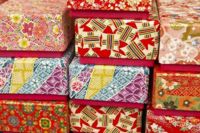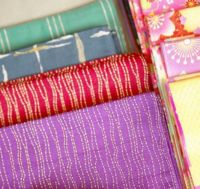Japanese Gift Wrapping
From Giftypedia
When giving gifts or sending presents in Japan, it is customary to show special care not only to the contents, but to the way a gift is wrapped and the wrapping itself. In Japanese culture, gift wrapping can be as important as the gift, where the gift is viewed as a form of communication between the giver and the receiver. The chosen gift wrapping serves an important role in shaping the messaging associated with the gift. In short, the wrapping is considered as part of the gift itself and should reflect both the gift being given and the emotions behind the gift.
The distinction of a gift being wrapped is an important one when it comes to receiving a gift. Except among close family members, gifts must not be unwrapped in front of the donor of the gift. The recipient should wait until later to open the gift.
[edit] Color Symbolism
Color symbolism is important in Japanese culture and should be taken into account when choosing a gift wrap. Red, for example, symbolizes life and vitality, so this type of wrapping signifies that a gift is for a favorable or fortunate occasion. Below, are some Japanese cultural meanings associated with colors...[1][2][3]
| Color | Meaning in Japanese Culture |
|
Red
|
Red symbolizes strong positive emotions such as life, energy and vitality. Though it can also symbolize anger, danger, vulgarity, excess and even sexual desire. Red should be avoided when sending cards as funeral notices are normally sent in red. |
|
Pink
|
Pink is well liked by both males and females and is viewed as a happy, positive color. |
|
Yellow
|
Yellow symbolizes courage, beauty and refinement, aristocracy and cheerfulness. |
|
Orange
|
Orange symbolizes happiness and love. |
|
Green
|
Green is a positive color and represents fertility, eternal life, youthfulness and freshness. Olive green is said to symbolize dignity. |
|
Blue
|
Blue is a soothing color that represents everyday life, purity and cleanliness. It is also regarded as a feminine color. |
|
Purple
|
Purple stands for privilege, wealth and nobility. |
|
White
|
White traditionally represents purity and cleanliness and is seen as a blessed color. It can symbolize death and rebirth. It is a common color for brides and at funerals. In Japan, the white carnation symbolizes death. |
|
Black
|
Similar to Western culture, black is associated with death, doom and sorrow. It can be used to represent morning and misfortune. Black is also seen as the color of mystery and the night. It also may be associated with feminine energy -- either in an evil or threatening way or in a provocative way. It is sometimes seen as an unlucky color. In more modern times, it can be seen as a sign of formality when associated with black tie events. |
|
Red & White |
Red and white together represent celebration and happiness, linking power and rebirth. |
|
Red & Black |
Red and black together represents sexuality. |
[edit] Styles of Japanese Gift Wrapping
There are many rules and customs of associated with Japanese gift wrapping, many of which imply how you feel towards the person and the the message behind the gift. The gift wrap color choices are one of ways that this communication takes place. Also, the wrapping of the gift is not necessarily meant to hide the gift, but to accentuate it -- with gift wraps designed to reveal some items while concealing others. A couple of other methods of symbolism that can be used...
- Pleating -- providing an odd number of pleats in your wrapping symbolizes joy
- Yin & Yang -- combining two different materials symbolizes the yin-yang that represent the interconnected and interdependent forces of the natural world
- Asymmetry -- asymmetry is considered more visually appealing in Japan culture
There are two main Japanese gift wrapping techniques...
[edit] Tsutsumi or Origata
One style of Japanese gift wrapping, called tsutsumi -- which means to cover, conceal or wrap -- or origata uses paper and fabric to wrappings for gifts, presents and packages. The unique aspect of this technique is that the paper and/or fabric is never cut. Instead it is pleated, folded and tied. Ranging from the simple to the sophisticated, this technique traditionally uses handmade paper (washi) to express beauty, etiquette and culture and often employs techniques seen in origami.
The intent with this wrapping style is not to conceal the gift, but to enhance it's shape and to give some clue to the contents. This style allows the gift itself to be exposed. For example, high quality tea leaves are often given as a present in Japan. When wrapping black tea (known as ko-cha, or "red tea"), red paper inserted in a slit on the top of the package, then overlaid with a film to provide a glimpse into what is in the package.
A sophisticated system of rules has been created for origata wrapping. The style depends on the gift recipient, the occasion, and even the season.
[edit] Furoshiki
A furoshiki is the technique of wrapping a gift with fabric. This style is perfect for birthdays, holidays, weddings, or everyday marketing and shopping and was originally used to carry clothes to the bathhouse. Made in a variety of sizes, the cloth is extremely handy and can be folded up after each use to wrap or carry something else. It 's very flexible as a wrapping technique and lends itself to various shapes and sizes of packages. There is even a way to wrap and carry two bottles together.
The Japanese Ministry of Environment has been promoting furoshiki to promote recycling, as the cloth can be reused for different occasions, helping to reduce the wasting of paper.
[edit] Related Guides
[edit] References
- ↑ Empower Yourself with Color Psychology
- ↑ eHow: What is the Meaning of Color in Japanese Culture
- ↑ Xerox: International Color Guide -- Japan




 Printer Friendly
Printer Friendly
